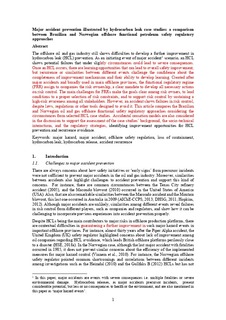| dc.contributor.author | Almeida, Alex Garcia de | |
| dc.contributor.author | Vinnem, Jan Erik | |
| dc.date.accessioned | 2019-11-18T11:51:25Z | |
| dc.date.available | 2019-11-18T11:51:25Z | |
| dc.date.created | 2019-10-18T12:43:16Z | |
| dc.date.issued | 2020 | |
| dc.identifier.citation | Safety Science. 2020, 121 652-665. | nb_NO |
| dc.identifier.issn | 0925-7535 | |
| dc.identifier.uri | http://hdl.handle.net/11250/2629009 | |
| dc.description.abstract | Despite laws, regulations, or risk management tools designed to avoid loss events, a hydrocarbon leak (HCL) in an offshore oil and gas platform1 is a major hazard event that reveals failures in risk control. In addition, similarities between different HCLs challenge the efficiency of current improvement mechanisms and the completeness of applied risk management practices. Accident causation models sustain that different roles in different levels, including regulators, companies, and the work environment, create the necessary conditions to a loss event, and therefore should be part of the accident analysis. This paper analyzes similar HCLs occurred in Norwegian and Brazilian offshore platforms to compare the regulatory approaches to risk control, aiming to identify influences related to the recurrence of HCLs in functional regulatory regimes (FRRs). As a result, each HCL among case studies consists of human errors that occurred while offshore crews were operating unsafe systems created by improper design or changes to address operational demands. An inappropriate context may support the impairment of safeguards that may not always be available or reliable in an environment which has as particular aspects the remoteness and the need to be self-sufficient. As a consequence, unsafe systems impose safety rules to offshore personnel and more relevance to human performance in the overall risk picture. In FRRs, the combination of regulatory requirements and enforcement activities is part of the safety context and influence risk owners’ behavior. The current comparison identifies differences between Brazilian and Norwegian regulatory regimes that may influence safety in offshore systems, as well as risk constraints related to human performance, which is strongly dependent on influencing factors such as safety culture. | nb_NO |
| dc.language.iso | eng | nb_NO |
| dc.publisher | Elsevier | nb_NO |
| dc.rights | Attribution-NonCommercial-NoDerivatives 4.0 Internasjonal | * |
| dc.rights.uri | http://creativecommons.org/licenses/by-nc-nd/4.0/deed.no | * |
| dc.title | Major accident prevention illustrated by hydrocarbon leak case studies: A comparison between Brazilian and Norwegian offshore functional petroleum safety regulatory approaches | nb_NO |
| dc.type | Journal article | nb_NO |
| dc.type | Peer reviewed | nb_NO |
| dc.description.version | acceptedVersion | nb_NO |
| dc.source.pagenumber | 652-665 | nb_NO |
| dc.source.volume | 121 | nb_NO |
| dc.source.journal | Safety Science | nb_NO |
| dc.identifier.doi | 10.1016/j.ssci.2019.08.028 | |
| dc.identifier.cristin | 1738397 | |
| dc.description.localcode | © 2019. This is the authors’ accepted and refereed manuscript to the article. Locked until 30.8.2021 due to copyright restrictions. This manuscript version is made available under the CC-BY-NC-ND 4.0 license http://creativecommons.org/licenses/by-nc-nd/4.0/ | nb_NO |
| cristin.unitcode | 194,64,20,0 | |
| cristin.unitname | Institutt for marin teknikk | |
| cristin.ispublished | true | |
| cristin.fulltext | postprint | |
| cristin.qualitycode | 1 | |

